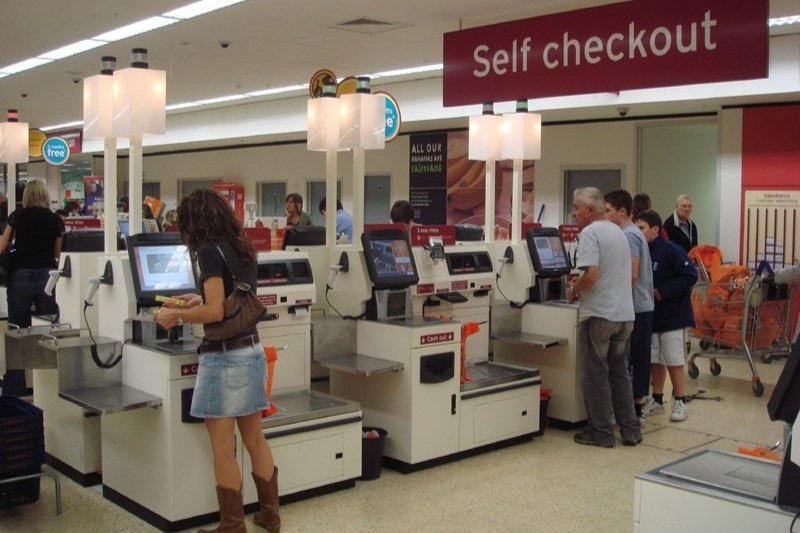Beware the Impersonal City
(Source: Flickr/pin add.)
A few Sundays ago, my husband and I found ourselves with a fierce hankering for soul food. We wanted large, steaming plates of fried catfish and greens. “Oh and hushpuppies,” I exclaimed as Rob pointed the car toward a well-known soul food restaurant on the edge of Waco.
Our excitement was cut short 15 minutes later as we pulled into an empty parking lot. We both sighed in exasperation: Waco’s restaurants have a reputation for being open and closed in an unpredictable fashion, due partly to COVID-era labor shortages and an old-school practice of closing shop on Sundays.
After several minutes of determined Google searching, we found a different soul food restaurant opened on Sundays, so we headed back across town to Sascee’s (pronounced “Sassy’s”), a family-run southern eatery located not far from downtown. With its pitch-black-tinted windows, Sascee’s at first seemed a bit mysterious. But seeing the doorway full of church folks in their Sunday finest, I was confident that we were in the right place. We opened the door to the aroma of home-cooked food that I grew up eating frequently, thanks to my father’s Southern roots.
Several men bustled around the roomful of customers, one of whom greeted us boisterously and ushered us to the back, where we could see the steaming trays of food available on the buffet. We grabbed two plates and moments later found ourselves digging into pork chops, fried chicken, cornbread, collard greens, dressing, and cabbage.
Between bites, we took in Sascee’s, not just as a restaurant, but as a third place for the mostly African-American neighborhood. It’s an incredibly social place. Folks greet each other with smiles. A little boy about five years old jumped around the front door, bouncing between employees, all of whom treated him like a little brother. At one point, he grinned, facing the door at the sight of an older African-American man standing on crutches, talking with folks outside. “Uncle Regie!” the boy exclaimed. The hostess made small talk with regulars waiting for pickup orders. All along the wall hung a variety of “Live, Love, Laugh” signs. It felt like eating in the fellowship halls of the Pentecostal churches I grew up visiting occasionally with family.
This dining experience contrasted pleasantly to a different eating-out experience that Rob and I experienced after Christmas. We went to redeem a gift card to Texas Roadhouse, a chain restaurant apparently famous for its hand-cut steaks and buttery rolls. Neither of us had ever been, but we love steak, so we were pretty excited when our name was called after a forty-five minute wait.
The hostess guided us to our seats through a large, loud, and colorful dining room. We slid into our benches at a cozy booth. As we neared the table, I found myself furrowing my brow, for there waiting for us was some version of an iPad-like device offering various games to play, designed obviously for children unaccustomed to eating out without a screen to accompany them.
I grabbed it, turned it face down and moved it out of sight, discouraged and slightly offended at the intrusion of technology on our St. Stephen’s Day meal. It was the latest in a long line of small technological “improvements” that we’ve encountered lately: self-checkout lines at Target, the self-ordering Kiosk at Panera Bread, and an entirely human-free move-in process at a local self storage facility. Yes, that’s right: we went through the entire process of opening an account and moving into a storage facility without interfacing with a human being.
I understand the convenience these changes bring… Self-checkout truly is faster and sometimes, I’m glad for the privacy. But for those of us trying to master the Strong Towns approach to community advocacy, the increasing automation and digitization of our everyday lives undermines three foundational “ingredients” for meaningful advocacy: observation, empathy, and connection.
Undermining Meaningful Observation
As you may know if you’ve been with us for a while, the Strong Towns approach to grassroots change starts by observing problems. Yet, this becomes a challenge if you’re inhabiting a built environment designed according to principles that prioritize a pace of movement that makes thoughtful observation difficult.
We’ve already experienced a dramatic “speeding up” of our presence in cities due to car-centric design. (After all, how much of your city can you really see when speeding around town at 45mph?) Now, with what I like to call “customer-tech,” it seems the next wave of “improvements” are set to strike our third places—our cafés, eateries and grocery stores—transforming them into hubs of speedy transactions: places you come to pick up your highly customized order as quickly and with as little human interaction as possible before dashing away.
Case in point: I’m working on this article from a Starbucks near our house and for the past hour or so, there’s been a steady flow of customers who have ordered their drinks through an app on their phone. Most of them walk in, grab their cup and walk out without looking up from their phone, removing their earphones, or speaking to the baristas behind the counter.
This kind of tech is designed to decrease the amount of time one spends in a place, thereby weakening the quality of attention we might pay to the environment and people around us. While this doesn’t make observation impossible, it can gradually change how we come to see the public sphere: as a highly-optimized, obstacle-free space for customized but impersonal transactions governed by speed and convenience.
Undermining Empathy
The risk of losing empathy is perhaps easier to envision. Effective grassroots advocacy needs heart strings that have been pulled, in order to get going. All advocacy, whether for bike lanes, third places, or safer streets, begins when someone observes a problem and is able to empathize with the effect it has on other people. But that’s a process that gets started with less personal moments, like those with baristas, grocers, bartenders, and even the post office clerk. Even if these moments are shallow, collectively, they give our neighborhoods personality, turning them into places worth caring about. Replacing them with impersonal technology threatens to upend the entire process of attachment that inspires care and that can lead to meaningful advocacy.
Undermining Connection
Anyone trying to improve their city knows that it’s most successful when approached as a team effort. We need to be connected with other people in our communities to rightly diagnose challenges and design plans of action. I’m not saying that self-checkout lines make it impossible to get connected to our neighbors, but when combined with other challenges, like smartphone addiction and a culture of driving that literally separates us from each other, it’s not hard to see how increased reliance on technology for these everyday experiences (i.e., buying a coffee or lunch) is only likely to increase a sense of social atomization while decreasing the quality of our loose ties.
An Old Challenge in New Clothes
So, what’s to be done? I doubt any of us can shake a stick at the slow creep of digitization taking over our lives. Self-checkout lanes, QR menus and no-contact food pickups are only likely to become more common. The allure of decreased marginal costs and increased convenience is just too powerful.
If history is any precedent, our society’s hyper focus on profit, speed, and individualism will come with a social cost and that is something we should take seriously. I’m currently reading The New Metropolis by Edward K. Spann, in which he argues that, despite New York City’s financial success, its imbalanced emphasis on commercial success compromised its ability to cultivate any meaningful vision of collective life, especially one that could effectively integrate the newly arrived mass of immigrants. As a result, the city struggled with violence, squalor, and poverty for decades.
Our challenge today is not quite as extreme (although I think the labor implications of increased robotics in the service industry merits serious consideration), but the threat of depersonalization remains very real. If our life patterns are marked by interacting with machines, robots, and screens, what will be the basis of any kind of collective life? What relationships will anchor our sense of place, our sense of home?





Trying to decide on your next smallest step? Chances are, your city already has systems in place to address infrastructure concerns. Strong Towns member Danny Williams demonstrates how you can use those systems to produce positive change.